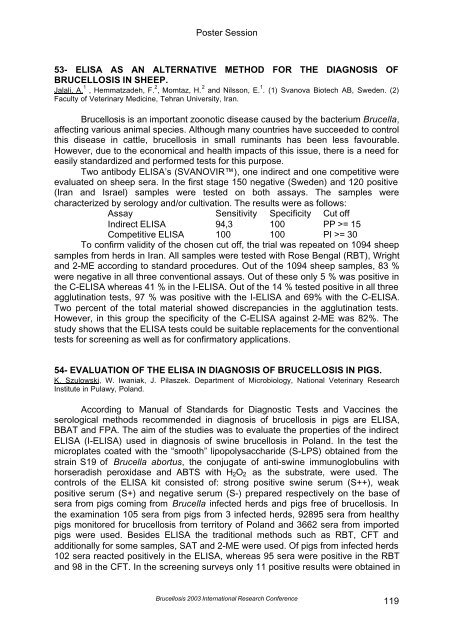Brucellosis 2003 proceedings - PHIDIAS
Brucellosis 2003 proceedings - PHIDIAS
Brucellosis 2003 proceedings - PHIDIAS
You also want an ePaper? Increase the reach of your titles
YUMPU automatically turns print PDFs into web optimized ePapers that Google loves.
Poster Session<br />
53- ELISA AS AN ALTERNATIVE METHOD FOR THE DIAGNOSIS OF<br />
BRUCELLOSIS IN SHEEP.<br />
Jalali, A. 1 , Hemmatzadeh, F. 2 , Momtaz, H. 2 and Nilsson, E. 1 . (1) Svanova Biotech AB, Sweden. (2)<br />
Faculty of Veterinary Medicine, Tehran University, Iran.<br />
<strong>Brucellosis</strong> is an important zoonotic disease caused by the bacterium Brucella,<br />
affecting various animal species. Although many countries have succeeded to control<br />
this disease in cattle, brucellosis in small ruminants has been less favourable.<br />
However, due to the economical and health impacts of this issue, there is a need for<br />
easily standardized and performed tests for this purpose.<br />
Two antibody ELISA’s (SVANOVIR), one indirect and one competitive were<br />
evaluated on sheep sera. In the first stage 150 negative (Sweden) and 120 positive<br />
(Iran and Israel) samples were tested on both assays. The samples were<br />
characterized by serology and/or cultivation. The results were as follows:<br />
Assay Sensitivity Specificity Cut off<br />
Indirect ELISA 94,3 100 PP >= 15<br />
Competitive ELISA 100 100 PI >= 30<br />
To confirm validity of the chosen cut off, the trial was repeated on 1094 sheep<br />
samples from herds in Iran. All samples were tested with Rose Bengal (RBT), Wright<br />
and 2-ME according to standard procedures. Out of the 1094 sheep samples, 83 %<br />
were negative in all three conventional assays. Out of these only 5 % was positive in<br />
the C-ELISA whereas 41 % in the I-ELISA. Out of the 14 % tested positive in all three<br />
agglutination tests, 97 % was positive with the I-ELISA and 69% with the C-ELISA.<br />
Two percent of the total material showed discrepancies in the agglutination tests.<br />
However, in this group the specificity of the C-ELISA against 2-ME was 82%. The<br />
study shows that the ELISA tests could be suitable replacements for the conventional<br />
tests for screening as well as for confirmatory applications.<br />
54- EVALUATION OF THE ELISA IN DIAGNOSIS OF BRUCELLOSIS IN PIGS.<br />
K. Szulowski, W. Iwaniak, J. Pilaszek. Department of Microbiology, National Veterinary Research<br />
Institute in Pulawy, Poland.<br />
According to Manual of Standards for Diagnostic Tests and Vaccines the<br />
serological methods recommended in diagnosis of brucellosis in pigs are ELISA,<br />
BBAT and FPA. The aim of the studies was to evaluate the properties of the indirect<br />
ELISA (I-ELISA) used in diagnosis of swine brucellosis in Poland. In the test the<br />
microplates coated with the “smooth” lipopolysaccharide (S-LPS) obtained from the<br />
strain S19 of Brucella abortus, the conjugate of anti-swine immunoglobulins with<br />
horseradish peroxidase and ABTS with H 2 O 2 as the substrate, were used. The<br />
controls of the ELISA kit consisted of: strong positive swine serum (S++), weak<br />
positive serum (S+) and negative serum (S-) prepared respectively on the base of<br />
sera from pigs coming from Brucella infected herds and pigs free of brucellosis. In<br />
the examination 105 sera from pigs from 3 infected herds, 92895 sera from healthy<br />
pigs monitored for brucellosis from territory of Poland and 3662 sera from imported<br />
pigs were used. Besides ELISA the traditional methods such as RBT, CFT and<br />
additionally for some samples, SAT and 2-ME were used. Of pigs from infected herds<br />
102 sera reacted positively in the ELISA, whereas 95 sera were positive in the RBT<br />
and 98 in the CFT. In the screening surveys only 11 positive results were obtained in<br />
<strong>Brucellosis</strong> <strong>2003</strong> International Research Conference<br />
119
















